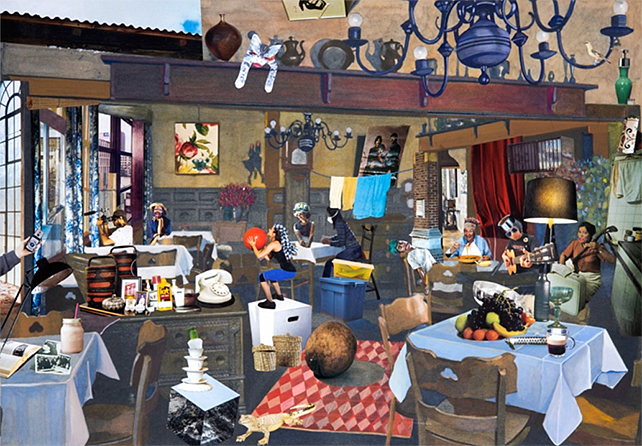
Umibaizurah, Afterwork #1, 2022, Gouache, Watercolor, Collage on Watercolor, Paper, Glass and Wood Frame, 66 x 85 cm
As more people worldwide pay attention and take action around climate change, the art world is joining in the movement toward a more sustainable and ethical future through art. Many artists from different parts of the world and generations are rethinking their work’s environmental impact and reengaging new methods and ways to educate the art world and the public about sustainability.
With the arrival of the new millennium, the artistic community continued to develop sustainable art, noting its impact at the social and environmental levels. As with sustainable architecture, sustainable artists now seek to optimize the use of natural resources to reduce the ecological footprint of their work. The relationship between art and sustainability, though, is not limited to physical media, be that sculpture created from natural materials or paintings made from materials respectful to the environment. It goes beyond what can be seen as a priori assumptions in work.
In Umi’s ideology, sustainability is present in many aspects of our everyday life. We ensure we take care of the environment, desire balanced economic development, and defend social well-being in many fields. She researched deep into the environmental discourse and used her knowledge to represent the significance of life on earth through her sculptures and drawings to show the importance of human life. As vividly demonstrated in her work, “To My Beloved Ocean,” on how critical it is to ensure its continuation through environmentalism. This a clarion call to make people consider and, hopefully, care about sustainability. The future of the places we call home and to think more critically about their roles in climate change or learn about an issue facing the environment differently.
Umi is particularly concerned about how we address sustainability issues in many aspects of our everyday life and how to raise awareness to motivate individuals to engage in sustainable consumption behaviours. Does economics overlook nature over the issue of consumer waste? In the series “Afterwork,” the works delved into humans’ over-consumption and excess materialism. What we demand from nature is that it does not exceed its supply in meeting human demands sustainably. We are used to seeing what is visible or what is apparent. Modern life demands various human needs and wants that are sometimes unnecessary. Human population growth has significant implications for our demands on nature, including future global consumption patterns. This persistent demand endangers the prosperity of current and future generations, fuelling considerable risk for our economies and well-being in many fields.
For Umi, her interaction with art and sustainability goes a long way, from a thematic perspective to media usage, to create the artwork. She said it allowed her to rethink her approach and what can be achieved. In the series of five “Still Life” sculptures, Umi cleverly mimics how artists can change the way art is created, upcycling from discarded items, food waste, and unused objects, transforming broken, mass products, which encourages avoiding waste and embracing imperfection and inspire social consciousness. While striving to meet the needs of the human population, consumption and production patterns must be fundamentally restructured. We must redeploy the ingenuity that justifies humanity’s demands on nature to bring about the transformation necessary to reimagine our relationship with nature. Good economics demands that we manage nature better.
Venue: ART SEASONS Singapore
50 Genting Lane, #03-02, Cideco Industrial Complex, Singapore 349558
When: 31 Oct - 3 Dec 2022,







